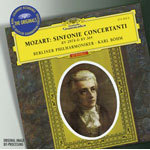
Mozart: Sinfonia concertante KV 297b / Sinfonia concertante KV 364
 $15.00
Special Order
$15.00
Special Order3 - 6 weeks add to cart
W. A. MOZART
Mozart: Sinfonia concertante KV 297b / Sinfonia concertante KV 364
Thomas Brandis (violin) Giusto Cappone (viola) Karl Steins (oboe) Karl Leister (clarinet) etc / Berliner Philharmoniker [Berlin Philharmonic], Karl Bo
[ Deutsche Grammophon The Originals / CD ]
Release Date: Monday 5 May 2003
This item is only available to us via Special Order. We should be able to get it to you in 3 - 6 weeks from when you order it.
An Attractive coupling, offering Mozart's two Sinfonie concertanti in outstanding recordings with an excellent team of soloists under the direction of Mozart specialist Karl Böhm.
"The account of the Sinfonia concertante (K297b) is of superlative quality, sounding amazingly idiomatic and well blended, with the balance between soloists and orchestra nicely managed. This is altogether refreshing." (Penguin Guide to Compact Discs)
An Attractive coupling, offering Mozart's two Sinfonie concertanti in outstanding recordings with an excellent team of soloists under the direction of Mozart specialist Karl Böhm.
The Berlin Philharmonic Orchestra was founded in 1882 by some 50 ambitious musicians who took their fate into their own hands and rebelled against the autocratic rule of Benjamin Bilse, in whose orchestra they had been playing. Many times financial difficulties threatened the young orchestra with dissolution. In 1887 the concert agent Hermann Wolff assumed the management and immediately contrived to achieve a certain guarantee of security. He was able to engage Hans von Bülow, the best, most modern and, in his working methods, most uncompromising conductor of the period. In only five years Bülow laid the foundation of the orchestra's style of playing. Guest conductors who came to Berlin included Hermann Levi, Felix Mottl, Felix von Weingartner, Ernst von Schuch, Johannes Brahms, Edvard Grieg, Gustav Mahler, Richard Strauss and Hans Pfitzner.
Arthur Nikisch followed Hans von Bülow in 1895. In the 27 years of his conductorship, he provided great artistic continuity. Nikisch enlarged the repertoire; he was a vehement advocate of Bruckner and indulged his preference for the works of Tchaikovsky, Berlioz, Liszt or "modern" works by Strauss and Mahler. Among the soloists of the Nikisch era are the pianists Ferruccio Busoni, Wilhelm Backhaus, Jacques Thibaut, Bronislav Huberman, Jascha Heifetz and Adolf Busch, the cellist Pablo Casals and famous singers from Maria Ivogün to Heinrich Schlusnus.
In 1923 Nikisch was succeeded by Wilhelm Furtwängler, who distinguished himself through his temperament, his passion, his reflective, almost philosophic attitude to interpretation, and through his unusual conducting technique of beating time with his right hand while shaping the line or marking the accents with the left. Furtwängler was the interpreter of Beethoven, Brahms and Bruckner. He was closer to the late romantic composers than to the composers of the new school; nevertheless, he still promoted works by Hindemith, Prokofiev, Stravinsky and Schoenberg. The orchestra came through the period of National Socialist dictatorship without serious harm.
It is astonishing how quickly musical life was rebuilt in a Berlin reduced to rubble after the collapse of 1945. The Philharmonic Orchestra, which in April had given its last concert before the capitulation, was able to perform again at the end of May under Leo Borchard with no great loss of members. Following Borchard's sudden death, the unknown and inexperienced 33-year-old Romanian Sergiu Celibidache was engaged as permanent conductor. He was a man of temperament, fire and fanaticism, though admittedly with a complicated personality. His concerts in a community hall in Zehlendorf, in the Titania-Palast and later in the Musikhochschule bore the stamp of the unusual. The isolation resulting from National Socialist cultural policy was rapidly overcome. Internationally famous soloists - the first being the violinist Yehudi Menuhin - and conductors began coming to Berlin again. The orchestra went on tour in Germany and abroad.
Wilhelm Furtwängler returned in 1946 and became Principal Conductor again in 1952. After his death (1954), the members of the Philharmonic Orchestra voted in 1955 to accept Herbert von Karajan as their Permanent Conductor and Artistic Director. In the next three decades, Karajan simultaneously achieved unique perfection and style and left a decisive stamp on the orchestral sound. Concerts, tours and innumerable recordings - in which the Berlin Philharmonic Orchestra "turn into" the Berliner Philharmoniker - bear testimony to the world-famous partnership. Since October 1963, the orchestra's home has been the Philharmonie on Kemperplatz. Certain exceptional status features have survived. Even as employees of Land Berlin, the musicians still form a "free orchestral republic" (Furtwängler) which is self-governing and has powerful rights.
In April 1989 Herbert von Karajan terminated his long partnership with the orchestra through his resignation as Permanent Conductor and Artistic Director, and he died the following July. In October, the Berlin Philharmonic Orchestra chose Claudio Abbado to be their fifth Artistic Director (Chief Conductor).
Claudio Abbado gave his first concert in his new capacity in December 1989, and assumed his new office at the commencement of the next concert season in September 1990. Since then twentieth century music has come to occupy a regular place in the concert programs alongside classical and romantic works. Every year, a particular theme provides a focus for the orchestra's work, for example, music inspired by the poetry of Hölderlin, "Faust", the Greek Tragedy (Oedipus, Elektra, Medea) or Shakespeare. The orchestra under Abbado has also started concert performances of operas in the Philharmonie.
Tracks:
Sinfonia concertante for Violin, Viola and Orchestra in E flat, K.364
Sinfonia concertante in E flat for Oboe, Clarinet, Horn,
Bassoon, Orch., K.297b
